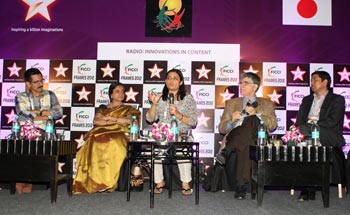MUMBAI: With the arrival of FM Phase-III, the radio industry is expecting to boom and prosper as the new policy will open up gateway of opportunities for the broadcasters. The policy extends FM radio services to about 227 new cities, in addition to the present 86 cities, with a total of 839 new FM radio stations. In spite of multiple opportunities, a snag that is still haunting the radio broadcasters is “Innovation”?
Is there innovation going to happen in radio? Should the stations innovate or just replicate the early era of radio, which used various kinds of content like talk shows, reality shows, regional music beyond playing bollywood music ? How can digital and social media be used to exploit and expand the opportunities in radio? Were the big questions raised, debated and discussed at one of the sessions of Ficci Frames 2012.
‘Radio: Innovations in Content’ moderated by Radio City CEO Apurva Purohit included panelists: Big FM business head Rabe Iyer, columnist & writer Bhavna Somaaya, O&M executive creative director Abhijit Avasthi, and Ryerson University chair of the Radio and Television Arts School of Media Charles Falzon.
Within the context of music, a lot more content can be created on radio. In the last five years it was not possible but today there are various opportunities to explore content on radio. There has been programmes like ‘Yaadon Ka Idiot Box’ on 92.7 Big FM, Ramayana on Fever 104 FM etc. “It is imperative that we innovate. With Phase-III we will have multiple frequencies which will help us grow. Entertainment agenda is fast changing and radio has to redefine sound than just being a source of entertainment,” Iyer said.
Providing a content creator or writer’s perspective on the concern, Somaaya noted, “Innovation is a very subjective term. It can only come through content, as technology has already been exhausted. Producers should get liaison and start doing informative content on radio as it is the most immediate medium amongst others.”
Taking the session further, Avasthi shared his views on strengthening the medium by creating innovative advertisements. He noted a very crucial fact that writing a radio spot was the toughest for an advertiser, than making a TV commercial or a print ad. “On radio you got to conjure an entire visual world in the person’s mind. Great advertising is not only about writing radio spots but it is to be a part of programming, and to create a blend of both is extremely difficult. Today dominant flavour on radio is Bollywood and the moment unique programming content opens up, it will lend into numerous opportunities for advertisers as there are lots of interesting things that can be done on this medium.”
Social media and digital were also seen as blooming opportunities. Falzon shared, “The whole world is experiencing a paradigm shift as to how entertainment can be used, be it on tablets, computers etc. The digital and social media particularly in Canada is used in many ways. Entertainment experience on radio can be extended through the digital medium. It becomes like a family of all different media with radio at its core.”
The discussion also found that radio stations should create their own content and then distribute it through various available channels. Rather than just relying on local or Bollywood music, radio can produce substantial content itself and then monetize it.
“Consumption of media and content has dramatically changed. It is a cognizant fact that today we have just become a distribution channel with music as our content. Through this distribution pipe (radio) we are giving out local or Bollywood music without programming our own content. The distribution part is the most vulnerable in the entire value chain,” added Purohit.
The discussion took an interesting turn when the audience raised questions and suggested of innovating programs like Hava Mahal on AIR. It was found that in the east and across the country, regional music is appreciated and Bollywood music is not at all dominant and demanded. There is scope for non-film music on radio and the private radio broadcasters should experiment. The panel aggressively noted that AIR has the liberty to broadcast news, sports commentary, unlike private FM stations. There are certain external constraints and restrictions put by the government on private FM radio like no news broadcast, operation of only one channel per city etc.
Purohit stated, “AIR is not given the responsibility of profitability and so they can experiment with innovative programming like obituaries, ghazals and instrumental music. We work on profitability and can perhaps experiment but not innovate consistently, as we are responsible to the share holders and the end consumers. It’s the listeners who give more ratings to Bollywood or local music, if they demand such programs we would be more than happy to play them. At the end consumers are our main focus. With FM Phase-III we will be able to innovate with massive opportunities.”
The session ended with mixed notions of radio being the most powerful and dynamic medium, but not celebrated and exhausted to its potential. Innovations in content is essential and required for survival in the extremely competitive market. Radio is the most and the only regulated medium, which prevents it from experimenting different concepts.
